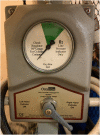Neonatal Applications of Heliox: A Practical Review
- PMID: 35359907
- PMCID: PMC8960277
- DOI: 10.3389/fped.2022.855050
Neonatal Applications of Heliox: A Practical Review
Abstract
Heliox is a mixture of helium and oxygen that may be utilized as an alternative to air-oxygen during the ventilatory support in the neonate. Special physical properties of Heliox, particularly low density, allow for improved gas flow and diffusion. First reports of Heliox use in the pediatric population were published in 1930s; however, this therapy has never gained widespread popularity despite its described beneficial effects. Historically, this was largely due to technical challenges associated with Heliox ventilation that significantly limited its use and realization of large-scale clinical trials. However, nowadays several commercially available ventilators allow easy and safe ventilation with both conventional and non-invasive modes. In the era of minimally invasive respiratory interventions in the newborn Heliox could be seen as a therapy that may potentially decrease the risk of non-invasive ventilation failure. This review presents pathophysiologic rationale for the use of Heliox in the newborn, and summarizes available data regarding applications of Heliox in the setting of neonatal intensive care unit based on clinical studies and findings from animal models. Mechanisms of action and practical aspects of Heliox delivery are thoroughly discussed. Finally, future research directions for neonatal use of Heliox are proposed.
Keywords: heliox; helium; mechanical ventilation; neonate; newborn; non-invasive respiratory support; respiratory distress; respiratory failure.
Copyright © 2022 Szczapa, Kwapień and Merritt.
Conflict of interest statement
The authors declare that the research was conducted in the absence of any commercial or financial relationships that could be construed as a potential conflict of interest.
Figures




References
Publication types
LinkOut - more resources
Full Text Sources

